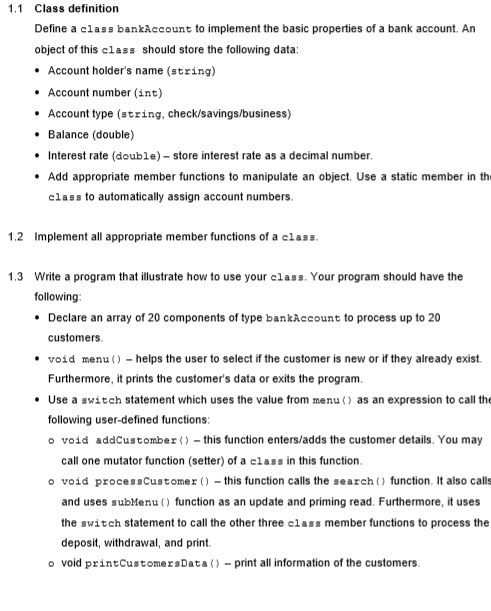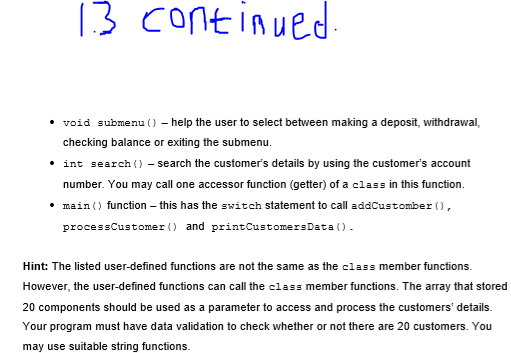write a program that illustrate how to use your class. Your program should have the following: Declare an array of 20 components of type bankAccount to process up to 20 customers.
OOPs
In today's technology-driven world, computer programming skills are in high demand. The object-oriented programming (OOP) approach is very much useful while designing and maintaining software programs. Object-oriented programming (OOP) is a basic programming paradigm that almost every developer has used at some stage in their career.
Constructor
The easiest way to think of a constructor in object-oriented programming (OOP) languages is:
1.1
Class definition
Define a class bankAccount to implement the basic properties of a bank account. An object of this class should store the following data:
- Account holder’s name (string)
- Account number (int)
- Account type (string, check/savings/business)
- Balance (double)
- Interest rate (double) – store interest rate as a decimal number.
- Add appropriate member functions to manipulate an object. Use a static member in the class to automatically assign account numbers.
1.2
Implement all appropriate member functions of a class.
1.3
write a program that illustrate how to use your class. Your program should have the following:
- Declare an array of 20 components of type bankAccount to process up to 20 customers.
- void menu() – helps the user to select if the customer is new or if they already exist. Furthermore, it prints the customer’s data or exits the program.
- Use a switch statement which uses the value from menu() as an expression to call the following user-defined functions:
- void addCustomber() – this function enters/adds the customer details. You may call one mutator function (setter) of a class in this function.
- void processCustomer() – this function calls the search() function. It also calls and uses subMenu() function as an update and priming read. Furthermore, it uses the switch statement to call the other three class member functions to process the deposit, withdrawal, and print.
- void printCustomersData() – print all information of the customers.
- void submenu() – help the user to select between making a deposit, withdrawal, checking balance or exiting the submenu.
- int search() – search the customer’s details by using the customer’s account number. You may call one accessor function (getter) of a class in this function.
- main() function – this has the switch statement to call addCustomber(), processCustomer() and printCustomersData().
Hint: The listed user-defined functions are not the same as the class member functions. However, the user-defined functions can call the class member functions. The array that stored 20 components should be used as a parameter to access and process the customers’ details. Your program must have data validation to check whether or not there are 20 customers. You may use suitable string functions.
Note: I need the answer for only 1.3
Answer for the first two parts as requested by you:
The C++ program contains mainly bankAccount.h is a header file that contains the data members and member functions of the bank account class. The bankAccount.cpp file contains the implementation of bankAccount class member functions. In the main.cpp file, create an object of the bankAccount class, and call set functions to the account holder name, type of account, balance amount, and rate of interest values. Then call getter functions to display the data values on the console window.
//Demonstration of the bankAccount header and implementation files
//man.cpp
//include header files
#include<iostream>
#include<string>
//include bankAccount.h header file
#include "bankAccount.h"
using namespace std;
int main()
{
//object of bankAccount class
bankAccount acct;
//Set name, type , balance and rate values
acct.setAccountHolderName("Johnson");
acct.setAccountType("Savings");
acct.setBalance(1000);
acct.setRate(10);
//Print the account number, account holder name, account type
//balance and rate values on the console window
cout<<"Account Number #: "<<bankAccount::accountnum<<endl;
cout<<"Name: "<<acct.getAccountHolderName()<<endl;
cout<<"AccountType: "<<acct.getAccountType()<<endl;
cout<<"Balance : "<<acct.getBalance()<<endl;
cout<<"Rate: "<<acct.getRate()<<endl;
system("pause");
return 0;
}
Step 3
1.1 Header file of bankAccount class
//bankAccount.h
#ifndef BANK_ACCOUNT
#define BANK_ACCOUNT
#include<iostream>
#include<string>
using namespace std;
//class bankAccount defintion
class bankAccount
{
private:
string holdername;
string accounttype;
double balance;
double rate;
public:
bankAccount();
//setter functions
void setAccountHolderName(string);
void setAccountType(string);
void setBalance(double);
void setRate(double);
//getter functions
string getAccountHolderName();
string getAccountType();
double getBalance();
double getRate();
static int accountnum;
};
#endif BANK_ACCOUNT
Step 4
1.2 implementation file of bankAccount class
//bankAccount.cpp
#include<iostream>
#include<string>
#include "bankAccount.h"
using namespace std;
int bankAccount::accountnum=0;
//constructor that automatically increases the accountnum by 1
bankAccount::bankAccount()
{
accountnum=accountnum+1;
}
void bankAccount::setAccountHolderName(string name)
{
holdername=name;
}
void bankAccount::setAccountType(string type)
{
accounttype=type;
}
void bankAccount::setBalance(double bal)
{
balance=bal;
}
void bankAccount::setRate(double r)
{
rate=r;
}
string bankAccount::getAccountHolderName()
{
return holdername;
}
string bankAccount::getAccountType()
{
return accounttype;
}
double bankAccount::getBalance()
{
return balance;
}
double bankAccount::getRate()
{
return rate;
}


Trending now
This is a popular solution!
Step by step
Solved in 3 steps with 2 images


